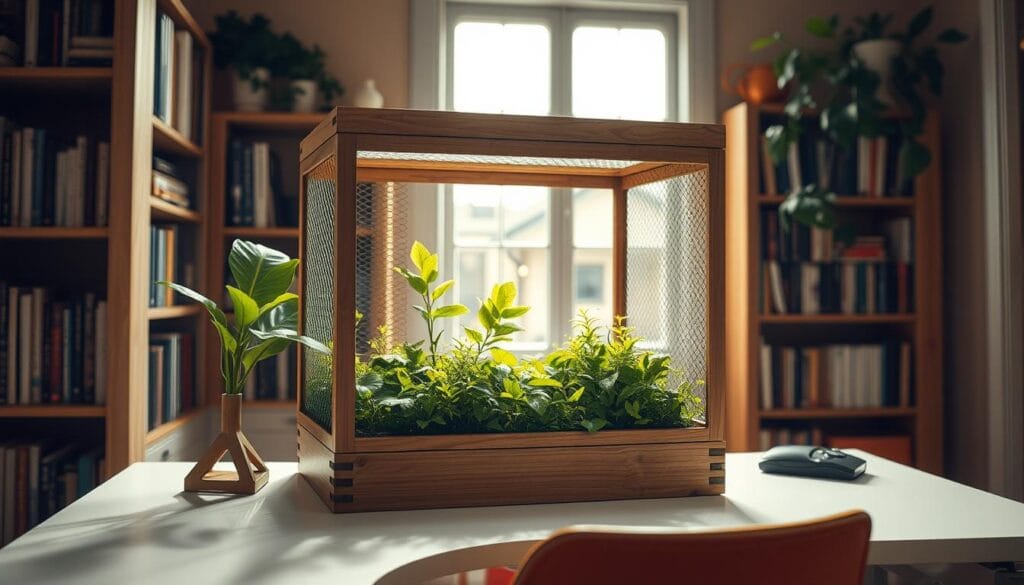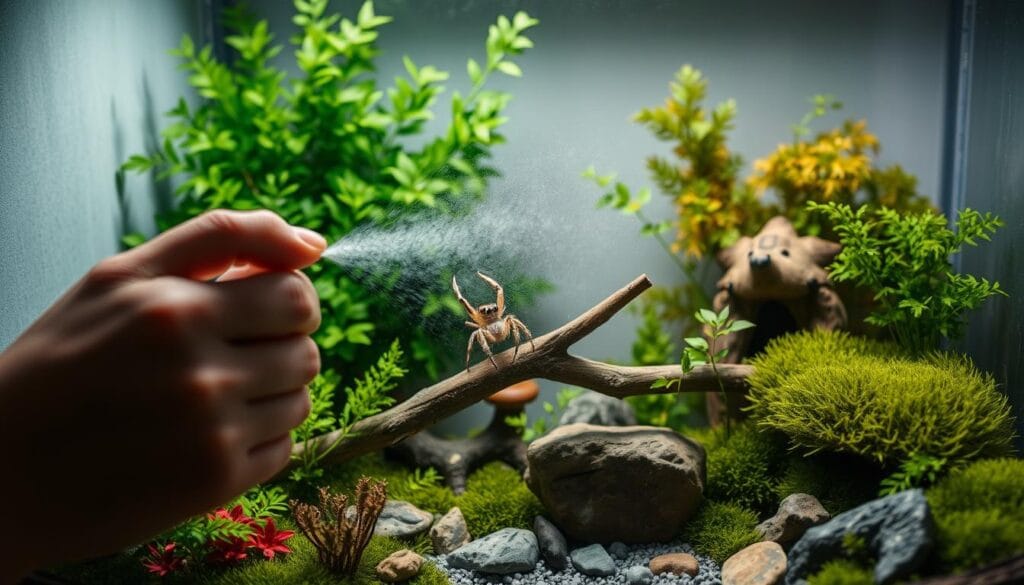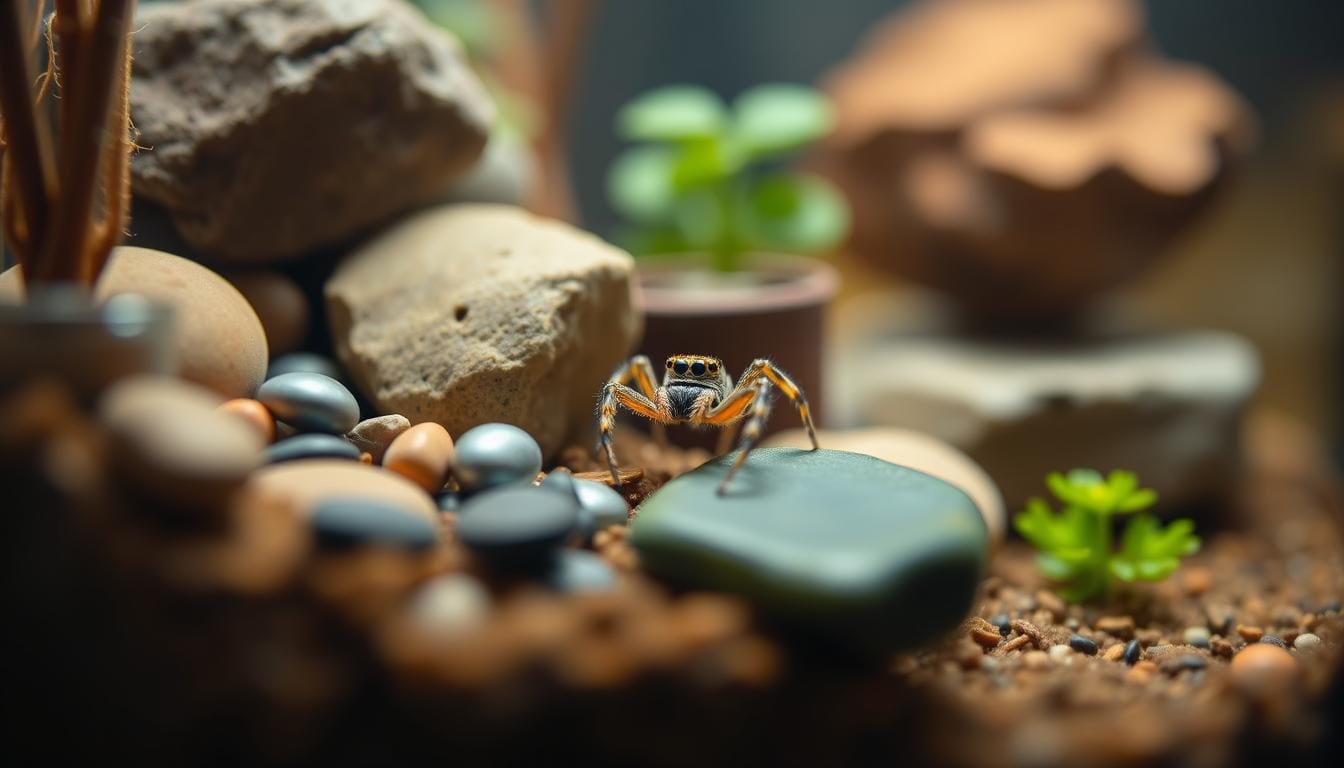Creating a home for your jumping spider is fun and rewarding. A terrarium provides a natural environment for your spider to thrive in.
To start, you’ll need some basic materials and knowledge of your spider‘s needs. This guide will help you create a safe and healthy space for your pet.
Table of Contents
Why Choose a Jumping Spider Terrarium?
Jumping spiders are fascinating creatures that can do well in a terrarium. Their interesting behavior and unique traits make them great to watch and study. By setting up a jumping spider terrarium, you can enjoy having these intriguing arachnids at home.
For more insights into the fascinating world of jumping spiders, you can visit exoticpethaven.com. It provides detailed information on their behavior and characteristics.
Unique Characteristics of Jumping Spiders
Jumping spiders are known for their amazing jumping ability. They use this to catch prey and move around. Experts say, “Jumping spiders have some of the most impressive vision among spiders, with some species having four pairs of eyes that provide nearly 360-degree vision.” This lets them spot movement and catch insects easily. Their agility and hunting skills make them fun to watch in a terrarium.
Benefits of Keeping a Jumping Spider
Keeping a jumping spider in a terrarium can be a rewarding hobby. It lets you observe these spiders up close. You can learn about their habits, like how they hunt and build webs (though they don’t make traditional webs). This experience is both educational and entertaining, helping you appreciate these fascinating creatures more.
Environmental Impact of Spiders
Spiders, including jumping spiders, are important in the ecosystem. They help control insect populations. As
“Spiders are among the most important predators of insects, helping to regulate their populations and maintain ecological balance.”
By keeping a jumping spider terrarium, you support these beneficial arachnids. You also help us understand their role in the environment.
Creating an easy jumping spider setup means understanding their needs and designing a terrarium for them. With the right care, your jumping spider can thrive. This will give you a fascinating and educational experience.
Materials You Will Need
To build your own spider terrarium, you’ll need a few key supplies. You’ll need to pick the right terrarium and add the right things to make it a cozy home for your spider.
Selecting the Right Terrarium
The terrarium is the heart of your spider’s home. Think about the size and type that fits your spider’s needs. A glass terrarium is best because it keeps humidity in and lets you see your spider. For jumping spiders, a small terrarium (5-10 gallons) is best. It’s easier to keep the humidity and temperature right.
Essential Supplies and Equipment
After picking your terrarium, you’ll need to add some important things. These include:
- Substrate (like peat moss or coconut fiber)
- A water dish
- Hiding spots (like small rocks or plants)
- A spray bottle for keeping humidity up
- A thermometer and hygrometer to check temperature and humidity
For more help on setting up an invertebrate terrarium, check out this step-by-step guide.
Optional Decorative Items
To make the terrarium more interesting, you can add some decorations. These might include:
- Live plants (like mosses or air plants)
- Decorative rocks or branches
- A background material (like cork bark)
These items make the terrarium look better and give your spider places to hide and explore.
| Supply | Purpose |
|---|---|
| Substrate | To line the bottom of the terrarium and keep humidity up |
| Water Dish | To give your spider water to drink |
| Hiding Places | To give your spider places to hide and feel safe |
Setting Up Your Terrarium
Getting ready to make a DIY spider habitat is exciting. You have all your materials, so now you can create a special place for your jumping spider.
Preparing the Terrarium Base
The terrarium’s base is important for looks and function. Start with a layer of small rocks or gravel. This helps with water drainage and keeps the substrate dry. Make sure the layer is 1-2 inches deep for good drainage without taking up too much space.
Adding Substrate and Decorations
Now, add the substrate. A mix of peat moss and perlite or coconut fiber is good for jumping spiders. It keeps moisture but also drains excess water. Fill the terrarium about 1/3 to 1/2 with the substrate. Then, add plants, branches, and decorations for hiding spots and climbing.
- Choose plants that are suitable for a terrarium environment, such as mosses or ferns.
- Add branches or rocks to create climbing structures and hiding places.
- Consider adding a small water dish for humidity, though jumping spiders don’t need standing water.
Ensuring Proper Ventilation
Good ventilation is key to keep the terrarium healthy. Make sure your terrarium has enough ventilation holes. You can also slightly offset the lid to allow for air exchange without losing humidity.
Arachnid experts say, “Proper ventilation is key to maintaining a healthy terrarium environment, as it prevents the buildup of stale air and reduces the risk of mold and fungal growth.”
“A well-ventilated terrarium is crucial for the health and well-being of your jumping spider.”
Choosing the Right Location
After setting up your homemade jumping spider enclosure, picking the right spot is key. The location greatly affects your spider’s health and happiness.
Sunlight and Temperature Considerations
Jumping spiders need a certain environment to do well. Think about the sunlight and temperature when choosing a spot. Direct sunlight can make the terrarium too hot. So, pick a place with indirect sunlight or use a sheer curtain to soften the sun’s rays.
Temperature is also very important. Make sure the terrarium is away from drafts, radiators, or air conditioning vents. Most jumping spiders like temperatures between 65°F to 75°F (18°C to 24°C).

Avoiding Common Hazards
When placing your terrarium, stay away from hazards. Keep it where children and pets can’t reach it to avoid accidents or disturbing the spider.
Also, make sure the terrarium is on a stable, flat surface. This way, it won’t get knocked over. Don’t put it near water or humid places to avoid too much moisture inside.
By choosing the right spot, you can make a safe and cozy home for your jumping spider. This will help it thrive in its new environment.
Acclimating Your Jumping Spider
Getting your jumping spider settled in is key to its happiness and health. It’s important to acclimate it well to its new terrarium. This helps reduce stress and makes the transition smoother.
Transporting the Spider Safely
When moving your jumping spider, handle it carefully. Use a secure, escape-proof container. You can opt for a small, ventilated box or a spider transport box. Make sure the container stays away from direct sunlight and extreme temperatures to avoid stressing the spider.
Introducing the Spider to Its New Home
Before letting your spider into its new terrarium, make sure everything is ready. Check the temperature and humidity levels are right for your spider. Gently release the spider into its new home, letting it explore without any trouble.
Watch how your spider acts and adjust the terrarium as needed. This ensures a comfortable and stress-free space for it.
Maintaining Your DIY Terrarium
Keeping your terrarium clean is crucial for your jumping spider’s health. Regular care ensures the spider stays happy and healthy. It also makes watching them more fun.
Regular Cleaning Routines
It’s important to clean your terrarium often. This stops waste and bacteria from building up. Every day, remove any poop, leftover food, and shed skin.
Also, change the substrate every week. This stops mold and bacteria from growing.
Step-by-Step Cleaning Guide:
- Remove your jumping spider to a temporary container.
- Take out any decorations and clean them with water.
- Replace the substrate with fresh material.
- Clean the terrarium walls with a damp cloth.
- Return the decorations and your spider to the terrarium.

Monitoring Humidity and Temperature
Jumping spiders need the right humidity and temperature. Use a hygrometer to check humidity, aiming for 60-80%. Keep the temperature between 75°F to 85°F (24°C to 30°C). Avoid drafts and direct sunlight.
| Environmental Factor | Ideal Range | Monitoring Tool |
|---|---|---|
| Humidity | 60-80% | Hygrometer |
| Temperature | 75°F – 85°F (24°C – 30°C) | Thermometer |
By following these tips, your DIY terrarium will be a great home for your jumping spider.
Feeding Your Jumping Spider
Feeding your jumping spider right is key to a great easy jumping spider setup. A well-fed spider is healthier and more fun to watch. Knowing what your spider eats is important for its health.
Types of Food They Prefer
Jumping spiders love to eat small insects. Their favorite foods are:
- Flies
- Crickets
- Moths
- Small beetles
It’s important to give your spider a variety of foods. You can raise your own insects or buy them from a pet store. Make sure to feed the insects nutritious foods before giving them to your spider.
Feeding Schedule and Techniques
The feeding schedule for jumping spiders depends on their age, size, and temperature. Adult spiders usually eat:
- Once every 2-3 days in summer
- Once every 4-5 days in winter
To feed your spider, put the prey near it in the terrarium. This helps them hunt naturally. Take out any leftover prey after a few hours to keep your spider and terrarium clean.
By following these tips, your jumping spider will stay healthy and happy. This makes your setup easy and fun.
Handling Your Jumping Spider
When you interact with your jumping spider, be gentle and understand its behavior. Building your own spider terrarium means creating a safe and comfy space. This makes handling your spider a positive experience for both you and your pet.
Gentle Handling Practices
To handle your jumping spider gently, start by letting it get used to you. Move your hand slowly towards the spider, and let it come to you. It’s important to be patient and not rush this process.
When you’re ready to pick up your spider, use a gentle scooping motion. You can use your hands or a soft-bristled brush to guide it onto your hand.
Key tips for gentle handling include:
- Moving slowly to avoid startling the spider
- Supporting the spider’s body when handling
- Not handling the spider excessively, as this can cause stress
Recognizing Signs of Stress
It’s important to know when your jumping spider is stressed. Stress can harm its health and well-being. Common signs of stress include:
- Rapidly moving away or attempting to escape
- Displaying threat postures, such as raising their abdomen
- Refusing to eat or showing a lack of interest in food
If you see these signs, give your spider some space and time to calm down. Keeping your spider’s terrarium clean and comfy can also help reduce stress.
By following these guidelines and watching your spider’s behavior, you can enjoy a rewarding experience building your own spider terrarium and interacting with your jumping spider.
Common Issues and Solutions
Creating a great home for your jumping spider needs careful attention and quick problem-solving. Even with the best care, issues can still pop up. Being ready to fix them is crucial.
Identifying Health Problems
Jumping spiders can get sick just like any other creature. Signs like dehydration, feeling tired, and not wanting to eat are common. If you see these, you must act fast to find and fix the problem.
For more tips on caring for your spider, check out this resource.
| Health Issue | Possible Cause | Solution |
|---|---|---|
| Dehydration | Low humidity or inadequate water supply | Increase humidity by misting the terrarium regularly and ensure a clean water source is available. |
| Lethargy | Stress, improper temperature, or inadequate nutrition | Check the temperature and ensure it’s within the optimal range. Provide a varied diet and minimize handling to reduce stress. |
| Loss of Appetite | Stress, improper feeding technique, or unsuitable prey | Review your feeding technique and ensure you’re offering prey that is appropriate for your spider’s size and species. |
Troubleshooting Environmentally Related Issues
Things like temperature, humidity, and light can really affect your spider’s health and your homemade spider terrarium design. Problems like mold, too much moisture, or bad air can be fixed by changing how you set up the terrarium.
If you see too much moisture inside, you might need to add more air vents. To stop mold, make sure it’s not too damp and there’s enough air moving around.
- Check for and remove any dead or decaying matter.
- Adjust the terrarium’s location to avoid direct sunlight, which can cause overheating.
- Monitor the terrarium’s temperature and humidity levels regularly.
By staying ahead and fixing problems fast, you can make a happy and healthy home for your jumping spider in your DIY terrarium for jumping spiders.
Resources for Jumping Spider Care
After setting up your spider terrarium, you might want to learn more about caring for your jumping spider. We’ve gathered a list of resources to help you improve your spider care skills.
Recommended Resources
Online forums and websites focused on arachnids are great places to start. They offer guides on feeding, handling, and keeping your spider healthy.
Local Experts and Communities
Talking to local experts and joining communities can also be very helpful. Look for arachnid clubs or online groups in your area. They can share valuable insights and tips for your DIY spider habitat.

